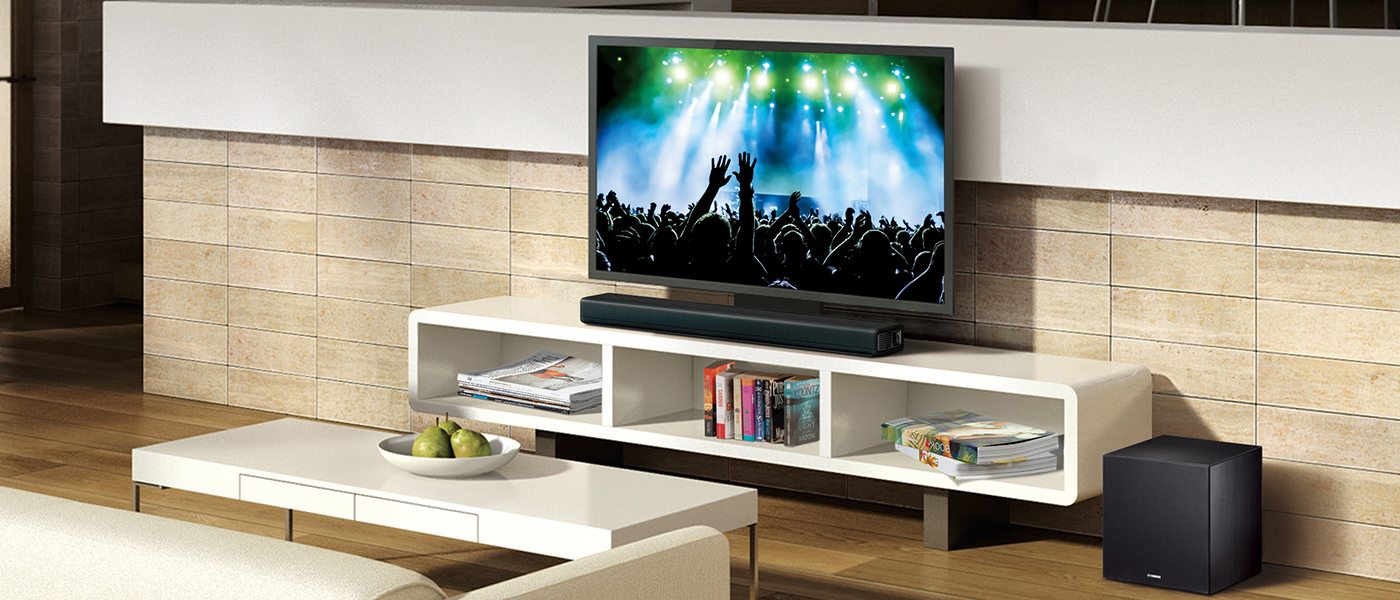The companion Bluesound PULSE Subwoofer adds additional depth and punch to the soundbar or any of the other Bluesound wireless speakers.
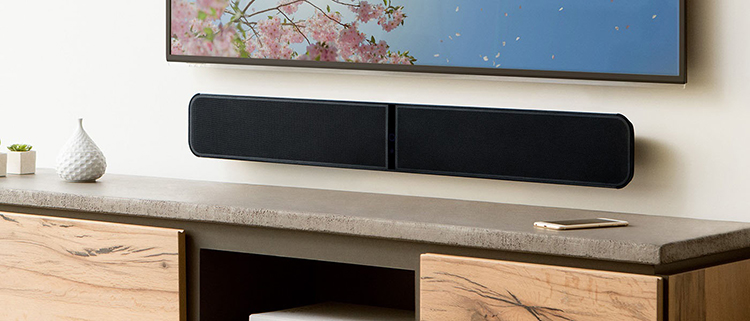
BlueSound PULSE Soundbar & Subwoofer
- Wireless speaker system with a full-featured mobile app for centralized control
- Soundbar form-factor for TV-centric aesthetics.
- Solid build-quality
- Ample connectivity
- Warm, rich sound
- MQA™ certified device
It’s probably a universal desire among music lovers to have easy access to your whole music collection, at any time, from any room in your house, inside or out. From juke-boxes, to multi-CD changers, to iPods/MP3 players; music fans have always wanted a way to keep all or most of their collection at their fingertips.
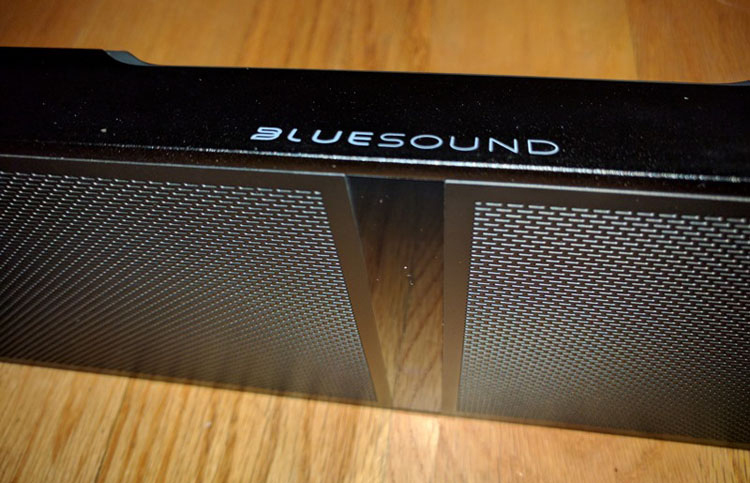
PULSE Soundbar
FREQUENCY RESPONSE:
+/- 1dB 70Hz-20kHz, 3dB down @ 55Hz,
With Sub: +/- 1dB 30Hz-20kHz, 3dB down @ 25Hz
DISTORTION (THD+NOISE):
-0.030%
PROCESSOR:
ARM Cortex – A9, 1 GHz
SPEAKERS:
Tweeter : 2 x .75” (19mm) Soft Dome
Mid-Range : 2 x 2” (50mm) Treated Paper Cone, Rubber Surround
Woofer : 2 x 4” (102mm) Rubber Surround
POWER OUTPUT:
120 watts of DirectDigital power
USB:
1 x Type-A (FAT32 Formatted) port for connection to USB memory sticks and supported peripherals, 1 x Type-B (mini) for product servicing
AUDIO INPUT:
Optical, RCA Line In, BluOS over Wi-Fi/LAN, aptX® Bluetooth
AUDIO OUTPUT:
Subwoofer out (RCA), Subwoofer out (wireless for BluOS subs only)
WEIGHT:
15lbs / 6.8kg
DIMENSIONS:
1073mm x 141mm x 70mm (42.25” x 5.5” x 2.75”) not including wall bracket or kickstands
BlueSound PULSE Soundbar MSRP:
$999
PULSE Subwoofer
Controls:
Volume, Crossover Frequency, Phase 0-180°, Standby, Pairing Mode
Connections:
Low & Line Level Inputs & Outputs, LFE Inputs & Outputs
Response:
On-axis @ 0°±3dB: 26-150Hz
LF Cutoff:
-10dB: 20Hz
Woofer (Nominal):
6.5” (165mm) Polypropylene cone, Elliptical Surround
Crossover:
50-150Hz
Power:
Continuous: 100W
Dynamic: 100w
Dynamic Peak: 200w
Type: Class D
DIMENSIONS:
447mm x 285mm x 122mm (17.6” x 11.25” x 4.8”) not including feet or wall bracket
Weight:
15.25 lbs
PULSE Subwoofer MSRP:
$599
Common to both
SUPPORTED FILE FORMATS:
MP3, AAC, WMA, OGG, WMA-L, ALAC, OPUS
Hi-Res formats – FLAC, MQA, WAV, AIFF, Dolby Digital
NATIVE SAMPLING RATES:
32 – 192kHz
BIT DEPTHS:
16-24
MOBILE APP:
iOS, Android (Google Play and Amazon Store)
DESKTOP APP:
OS/X, Windows (XP through 10)
FILE STORAGE:
Plays music from network shares on: Microsoft Windows XP, 2000, Vista 7-10 Apple Macintosh 7-10, as well as SMB and NFS shares from Linux-based systems (e.g. NAS)
SUPPORTED CLOUD SERVICES:
WiMP, Slacker Radio, Qobuz, HighResAudio, JUKE, Deezer, Murfie, HDTracks, Spotify, TIDAL, Napster, Microsoft Groove (with OneDrive), Classics Online, KKBox.
FREE INTERNET RADIO:
TuneIn Radio, IHeartRadio, Radio Paradise
NETWORK CONNECTIVITY:
Gigabit Ethernet (RJ45), 802.11b/g/n WiFi
Company:
SECRETS Tags:
BlueSound, PULSE, Soundbar, Subwoofer, Subwoofer Reviews 2017, Soundbar Reviews 2017
Where to Buy:
Now, we finally do have much, if not all our music at our fingertips thanks to smartphones and other digital storage devices. There are many ways to play digital media on home entertainment systems, like Airplay, DLNA, Bluetooth, and other methods that connect digital media devices to receivers, amplifiers, and speakers through a wired or wireless home network.
The wireless speaker paradigm takes that last part – receivers, amplifiers, and speakers (and wires) – and bundles them together into stand-alone self-powered Wi-Fi speakers, networked and controlled together via a mobile device app.
The Bluesound ecosystem of wireless speakers is operated via the BluOS smartphone app. The app can serve as your only method of interacting with the Bluesound speaker system. No additional or optional remote, no transport controls on the speaker itself; just the app, available on iOS, Android (both Google and Amazon flavors), as well as desktop apps for Windows and OS/X.
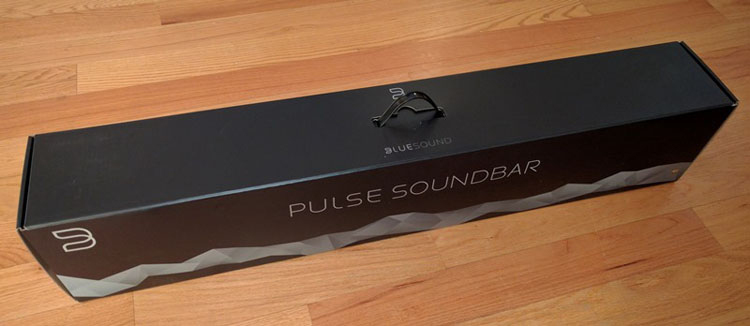
Bluesound sent me both the PULSE Soundbar and the companion PULSE Sub.

The sub came a couple weeks after the soundbar, so I had some time to get used to the soundbar’s unaided performance. The two speakers are matched in design and are housed in a modern minimalist metal body with a matte dark gray finish. I felt like it would blend well into most environments where a large flat-screen HDTV would sit above it as a centerpiece. At over 42” wide, it’s hardly inconspicuous, but I didn’t mind it at all.
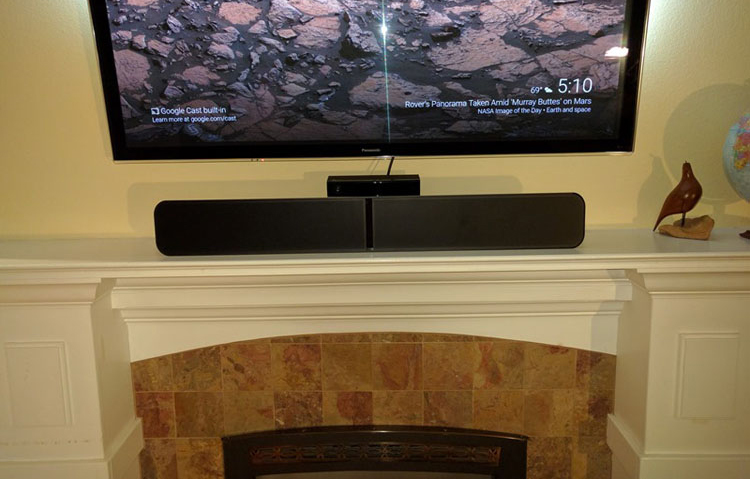
Besides, that large enclosure allows for some impressive drivers, six altogether: two tweeters, two mids, and two woofers. The metal body and built-in amplifiers give the PULSE Soundbar some serious heft; you’ll have no concerns about its acoustic stability.
The physical design of the Bluesound PULSE Sub matches that of the PULSE Soundbar to a “T.”
With the same minimalist aesthetic. The size though will surprise you. Make no mistake, that 4.8” depth is no lie. This sub is very slim, which allows it to hide better than most. It even comes with bracketry that allows you to hang it on a wall.
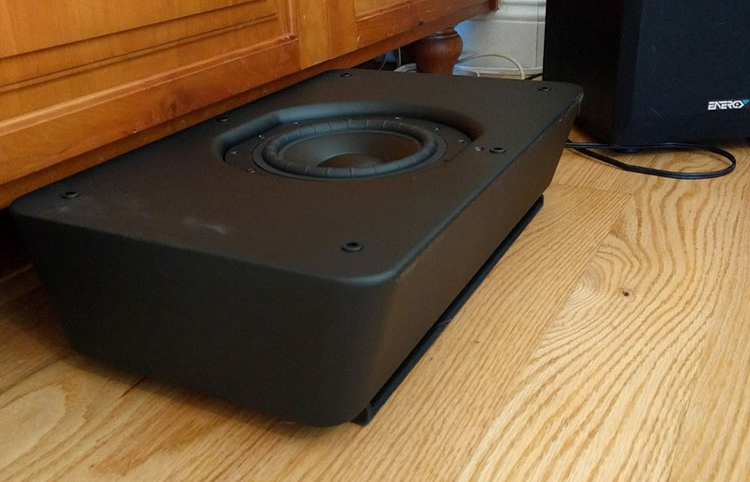
Getting started with a Bluesound wireless speaker system is pretty simple: plug in the speaker, download and install the app on your digital device (mobile, tablet, or desktop), pair the speaker, tell the app where your music is stored, and start playing. The initial pairing of the speaker to the network and then to the mobile device was a little involved, but very straightforward and similar to many other Wi-Fi-based devices. The PULSE Soundbar enters a hotspot mode when first powered on. You jump on that Wi-Fi with a phone to connect the Soundbar to your home network. It takes a few steps, but they are simple and well laid out and I experienced no issues here.
I had a little trouble locating my music shares via the BluOS app. I store all my media on a 10TB NAS and share it via network protocols like SMB and NFS. The BluOS app made it seem like I should be able to simply browse my network and select the music folder, but this didn’t work. I ended up contacting support, and they explained that I simply needed to type in the full network address of the share location, for example “//myNASname/volume1/Music” (without the quotes). That was easy enough, and I’ve had no trouble since then. Now when I add new music to my NAS, it shows up in the BluOS app.
Secrets Sponsor
The PULSE Sub was even easier to set up, since the BluOS app was already installed on my phone, and the Soundbar was already paired and working. I simply plugged the Sub in to power, let it initialize, then selected “Add A Player” from the BluOS app and followed the in-app prompts. Within seconds I had the Sub cranking. Although I found no need to adjust the default settings – they were already in the positions recommended by Paul Barton during our conversation – there is a full suite of analog adjustments for the sub hidden under a rubber cover on the top of the sub.
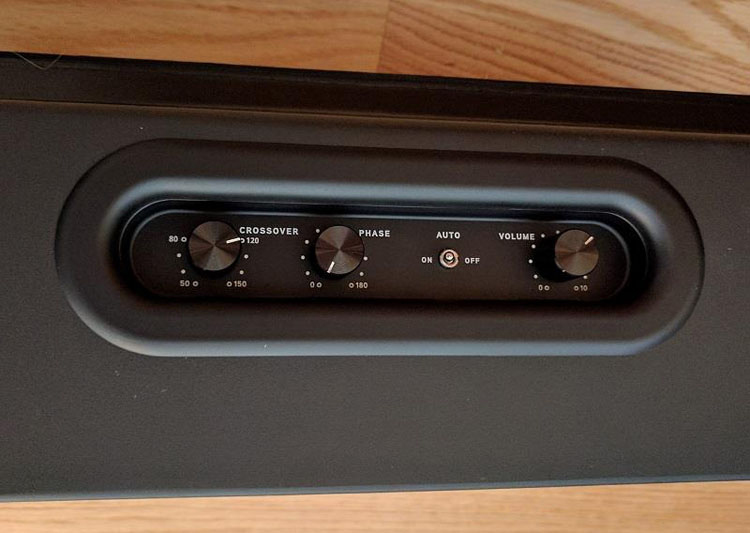
One glitch worth mentioning, not a fault of the Bluesound system, occurred when sending audio from my TV to the PULSE Soundbar. Despite the fact that my TV is a fairly high-end (if a few years old) model (Panasonic VT60 series), it turns out that there’s no way to get audio out from the RCA jacks on the TV and turn off the speakers of the TV.

The workaround was to use the TosLink optical audio out from the TV to the PULSE Soundbar. This worked fine, so if you have trouble getting audio out from your TV to the Soundbar, try a different output.
The BlueOS software comes with ample adjustments for every aspect of the Soundbar including lip-sync delay, dialog enhancement, “wide” mode, “deep bass” mode, treble/bass, and a subwoofer specific section that includes a delay slider.
My colleague Jay Haider wrote a review of the Bluesound Gen 2 Wireless Multi-Room Music System in which he covered the BluOS experience in great detail. Not much has changed on the surface since then. The BluOS app is well-refined, and revisions to the software since his review have added new features like MQA compatibility, which I’ll get to shortly.
The first listening I did with the PULSE Soundbar was from my home server/NAS, which holds my entire music collection in a mix of MP3 and FLAC formats (and now a few samples of MQA media).

A few of my standards for critiquing audio components are Dire Straits best-of album, Sultans of Swing from Mercury Records, Telarc’s Copland: The Music of America, and Norah Jones’ Come Away With Me from Blue Note Records. I know the opening notes of these albums so well that I can often make a judgement within a few seconds as to whether I like a component or not. It’s when I find myself listening to entire songs, or even several songs without realizing it, that I know I’ve found something special. That’s what happened with the Bluesound PULSE Soundbar, I listened to whole songs – several songs – anxious to hear how the next part would sound on this new, impressive speaker.
Secrets Sponsor
But allow me to back up a little. My initial impression was not so favorable; my immediate reaction on first listen was one of profound interest in the sound, but I wasn’t sure I liked what I heard. It was different: detailed, but warm and soft; full, but mellow. I tend to prefer a brighter sound from my audio components. I like to hear the details of the high frequency elements, the aberrant finger drag across the guitar string, the barely heard harmonic of the tympani drums, or the singer’s lips gently smacking as they take a breath. At first I felt like I wasn’t going to hear these details with the PULSE Soundbar. But I was wrong; I could hear the details I sought, it was just that the overall sound was less harsh and crisp than what I was used to. This is what drew me in and had me listening to more music; what was it about this speaker that was so different yet still so good?
For sure the PULSE Soundbar improved with every listen, the so-called “break-in” period was possibly at work here, and possibly my own psycho-acoustic remodeling too. I was simply coming around to really liking the sound of this speaker.

This Bluesound system was the first system I’ve auditioned that supports the MQA audio file format from Meridian. I won’t turn this article into a review of MQA as a format, but suffice it to say I was impressed while demoing some high-resolution audio samples I downloaded in both MQA and traditional high-res PCM.
If you’re looking for some MQA samples to try, check out The Nordic Sound where several free (legal and legitimate) downloads are available. I downloaded several file types of Mozart: Violin concerto in D major – Allegro, by Marianne Thorsen / TrondheimSolistene.
The website makes this piece available in both high-resolution stereo PCM (24- bit/ 192kHz), and MQA. The MQA file was less than one-third the size of the PCM file, though still larger than the standard CD resolution file that was available.
The Bluesound system played every file type I threw at it, from FLAC to PCM, to MQA, and while I need to do some more auditions and tests before forming a strong opinion about MQA as a format for high-resolution music, my initial impressions are positive. In fact, whereas I usually preferred the sharper sound of my Energy system for most music, when I compared it playing the high-resolution PCM version of the Mozart concerto, against the MQA files played on the Bluesound system, I preferred the latter. Highs were crisp and clear, and the mid-range full and mellow. This is only one recording of one performance though. Regardless if you’re a fan of MQA, the Bluesound system can handle it very well, and it plays the files as effortlessly as any other file type.
My comparison setup was a small satellite + sub system from Energy. With a dedicated subwoofer, the Energy system outclassed the PULSE Soundbar in low-end extension, but only barely. The soundbar had impressive low-end extension by itself. For music, I almost didn’t need a sub. With the addition of the Bluesound PULSE Sub to the system though, the low end filled out nicely and I had a harder time choosing which had better low end extension for music.
For television and movie viewing, I found the differences between the PULSE Soundbar and my standard speakers to be less pronounced. Due to the nature of my satellite speaker setup the sound stage was a little wider with my speakers than with the Soundbar, but overall the sound quality was very good with the Soundbar for use with video sources. I tried the “wide” mode which opened up the sound stage a bit. I’m generally not a fan of DSP modes to simulate something that isn’t there. So for me, wide mode didn’t really compare to having actual surround speakers located throughout the room. Granted, people shopping for a soundbar are not likely to be considering a full surround-sound system, so this may not be a fair comparison. For smaller rooms without a surround sound set up, wide mode adds to the overall presence when watching movies.

Low-end extension was more noticeably lacking in the PULSE Soundbar for action movies that make heavy use of the LFE channel. Also, that crisp and bright sound I tend to prefer in my speakers was absent when watching TV and movies, but I didn’t really miss it. For movies and TV, the mellow, neutral sound of the PULSE Soundbar was quite nice and dialog was very clear and natural.
The addition of the PULSE Sub helped the action movie experience, but not as much so with music (since it generally demands less in the low end). The PULSE Sub is a very cool piece of equipment design-wise, but it is still limited by the physics of such a small enclosure, and this was noticeable when doing A/B comparison of LFE-heavy movie scenes. While watching The Dark Knight Blu Ray, the scene when the Joker detonates the bomb in the hospital had more low-frequency rumble and punch with my Energy sub than with the Bluesound Sub. My reference Energy subwoofer is no behemoth, mind you. It’s an 8” driver in a wooden ported enclosure. The Bluesound PULSE Sub by comparison, is a 6.5” driver in a small, sealed enclosure. Both subs have a comparable 100 watts of power to draw upon. The Energy sub just seemed to have more punch at the low end, especially for action movies. The Bluesound system filled out the high-bass region better though. My satellite-sub system, as much as I like it, has a bit of a gap in the third octave (i.e. approximately 80-160 Hz). The smooth transition from low bass (20-80Hz) to high bass (80-200 Hz) from the Bluesound Sub was evident with dialog, especially male voices. With my Energy sat + sub combo, the sub adds some missing depth to male voices, but in comparison to the Bluesound system, the Energy system was lacking in mid-high bass-range voices, especially male voices which were slightly more natural sounding with the Bluesound system. In the end though, the PULSE Soundbar’s low end extension is so good by itself, that I didn’t feel the PULSE Sub really added enough to warrant the extra cost. If you feel you need or want more low end punch, I’d consider foregoing the wireless aspect and hook up a good traditional sub with a larger driver. Or better yet, and this suggestion comes from Paul Barton, add a second PULSE sub. That will smooth out bass response AND add 6dB to the output. On the other hand, a single PULSE Sub does add some extension and blends seamlessly with the Soundbar. So, if your room environment requires a small, or hidden, and/or wireless subwoofer, then the PULSE Sub is ideal.
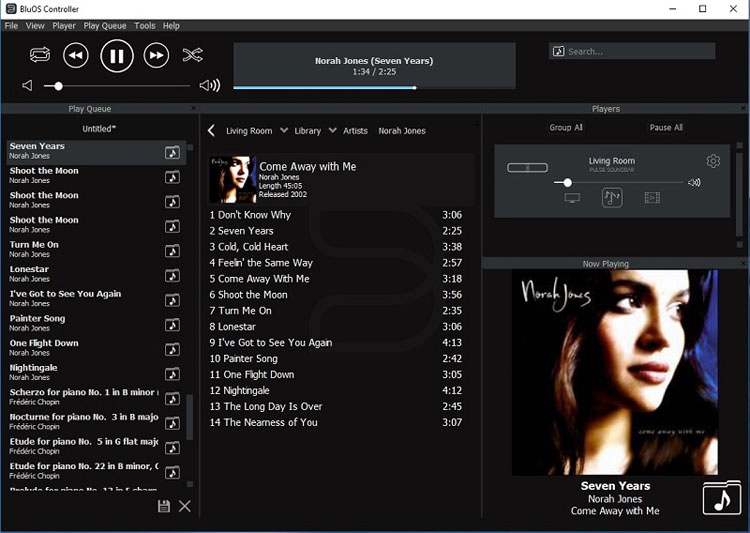
One nice, late discovery I made while demoing the Bluesound PULSE Soundbar is that it supports infra-red remote controls. I discovered this while digging around in the settings of the BluOS desktop Windows app. Its functionality is somewhat limited (only 10 functions), but that was ample for typical daily use. Like my FLIRC universal IR adapter, the Bluesound PULSE Soundbar required a bit of initial programming to work with my Logitech Harmony 650 IR remote. First, one needs to add a compatible IR remote code base to the Harmony. In this case Bluesound’s help pages recommend adding one from an NAD pre-amp remote. Then from the desktop app settings menu, and using the Harmony in that mode, you can program the Soundbar to bind a given IR signal from the Harmony (acting as a NAD pre-amp remote) like “volume up” to a given function within the Soundbar (e.g. “volume up” in this case). This was a huge benefit when using the Soundbar with my Harmony for movies and TV. Before I figured this out, I found it annoying to use my phone or tablet to control the volume while watching a show or a movie. With the system paired to my Harmony, I could control volume normally just as I would control it with my main AVR. This was a very nice bonus feature that I wished I’d noticed earlier in my testing!
Another small surprise was that the Bluesound PULSE Soundbar worked with the computers in our house via Bluetooth (with aptX compression). So, we could watch YouTube videos on the family room computer and pipe the sound through the PULSE Soundbar. I have some mobile devices with Bluetooth AptX compatibility, but I’ve not really noticed the benefit there, and since the Bluesound system is already tied into the network and can read my whole media collection directly from my server, there wasn’t much point in using Bluetooth for anything more than getting PC sounds out to a better speaker.
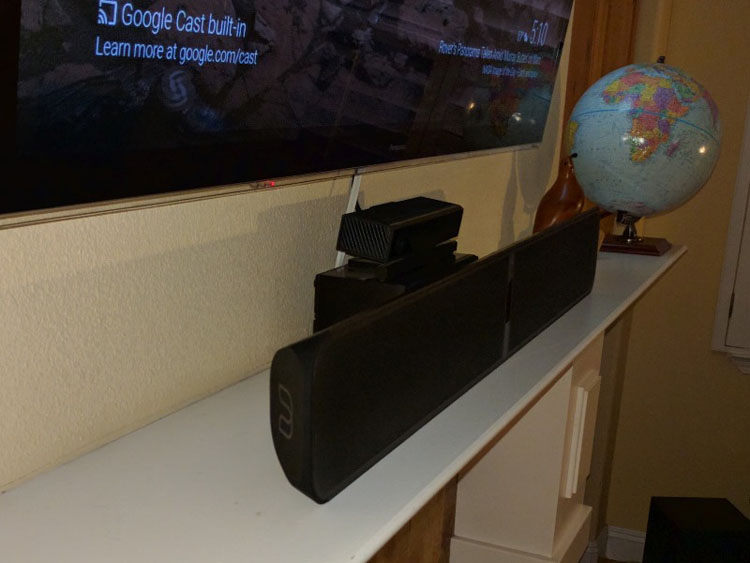
THE BLUESOUND PULSE SOUNDBAR Provides Strong Price And Performance Competition To Similar Products In The High-end Market This Year.
- Awesome BluOS app available on most mobile devices and desktops
- Excellent build quality
- Warm, rich sound with impressive low end extension (Soundbar only)
- More output from the PULSE sub
- Better high-end detail, less high-end roll-off
- Included optical TOSLINK cable for TV connection
The Bluesound PULSE Soundbar is a very nice, well designed, high-end lifestyle soundbar. It has a warm, neutral, flat-response sound that will appeal to audiophiles who prefer few or no enhancements to the sound of the original source media. My initial reaction was reserved, but after an ample break-in period, and some time getting used to softer highs and rich mids, I really liked this speaker. The matching Bluesound PULSE Sub adds some depth to the already impressive response of the Soundbar itself, and its design allows it to be hidden virtually anywhere. However, for a more impressive full-range system, I’d recommend either a second PULSE sub or a larger traditional one. This would require adding wires to this impressive wireless system though, so if that is not an option, the PULSE Sub is a great high-aesthetic addition to the Soundbar that integrates wirelessly to your whole Bluesound system. The system itself is also very well designed with the mobile (or desktop) BluOS app able that controls every facet of setup and use. The BluOS app is easy to use and navigate, although I did occasionally want for the physical buttons of a more traditional remote. Fortunately, the PULSE Soundbar does support IR inputs if you’re like me and sometimes don’t want to have to wake up your phone to quickly change the volume. This Bluesound system has a lot to offer, and for the price it should. At just shy of $1000 for the Soundbar alone, there are many other options out there for less than half the price, including the offering from that “other” wireless speaker brand, Sonos. The Bluesound PULSE Soundbar has audiophile features and performance though. So, if you’re in the market for high-end wireless speakers, Bluesound is definitely worth a listen.


